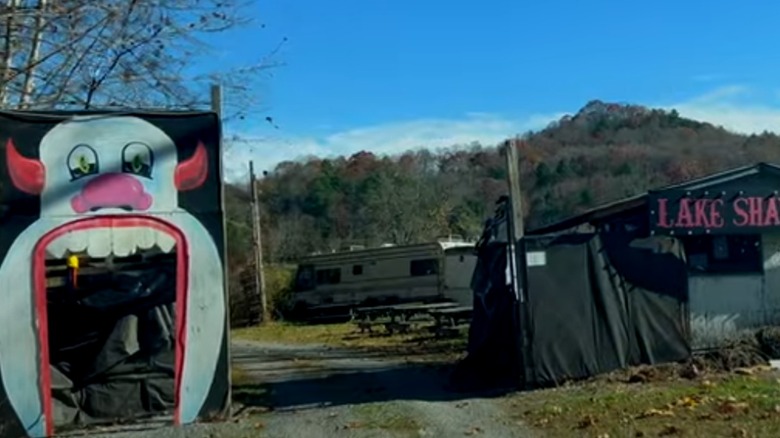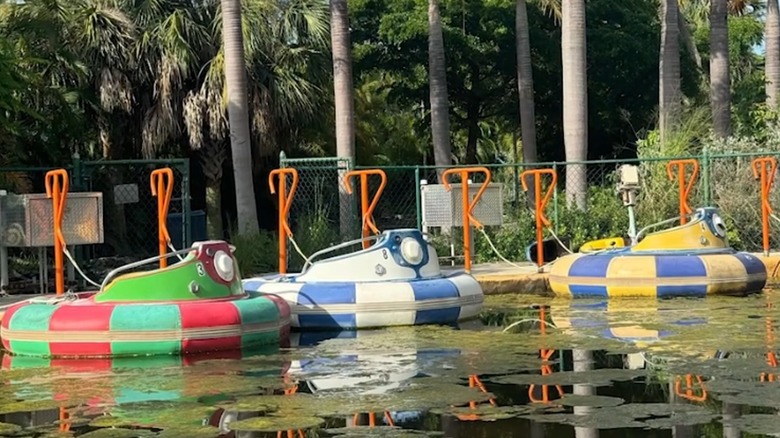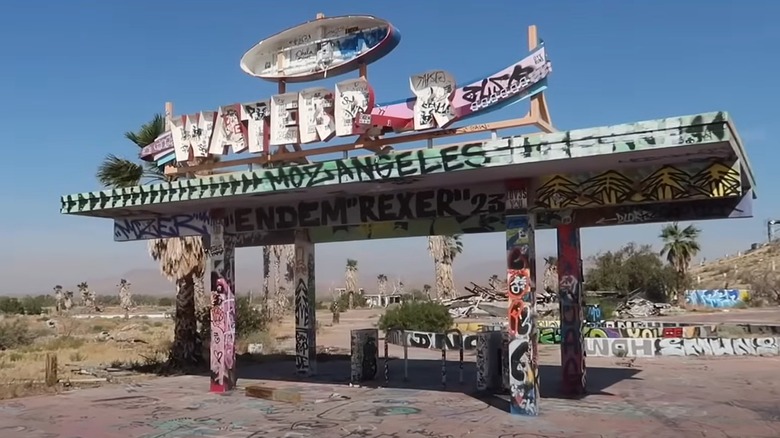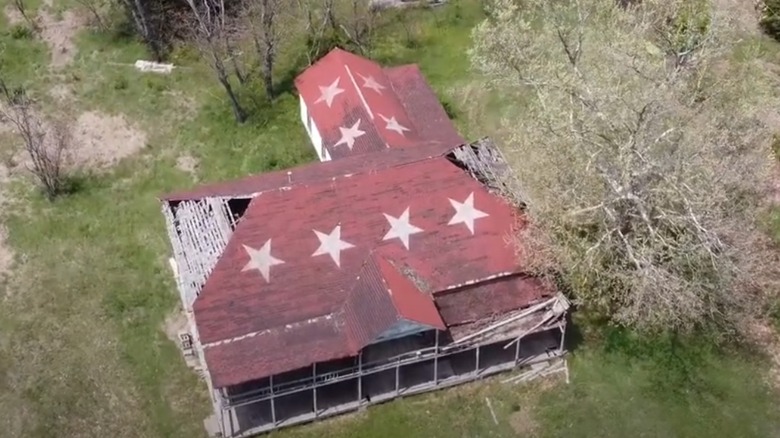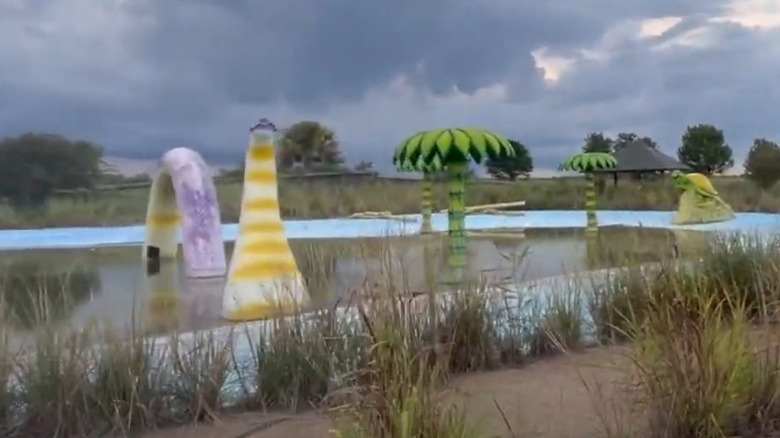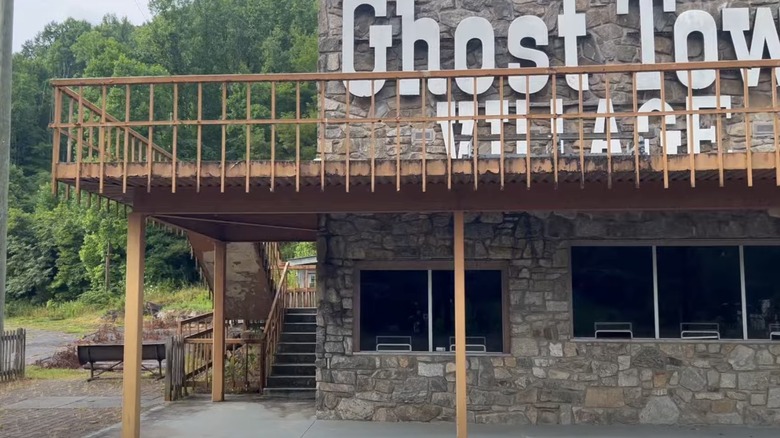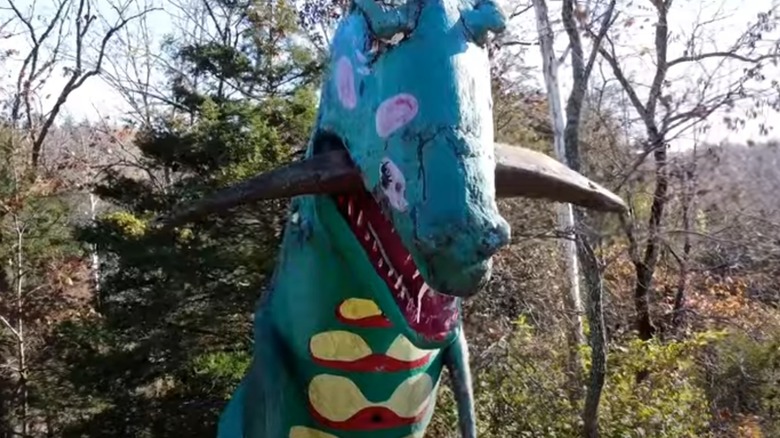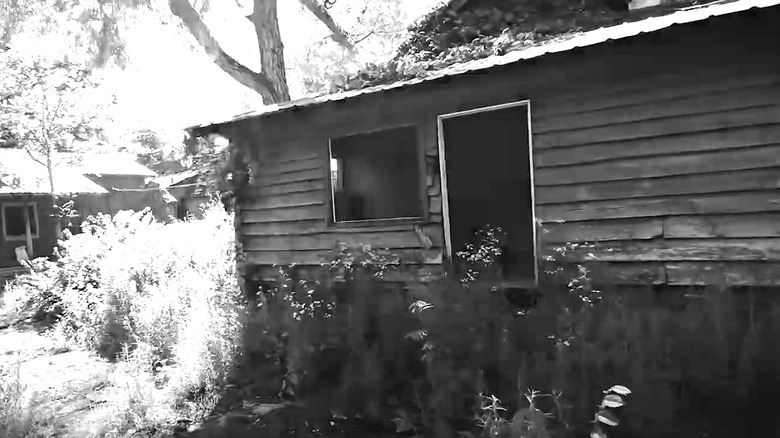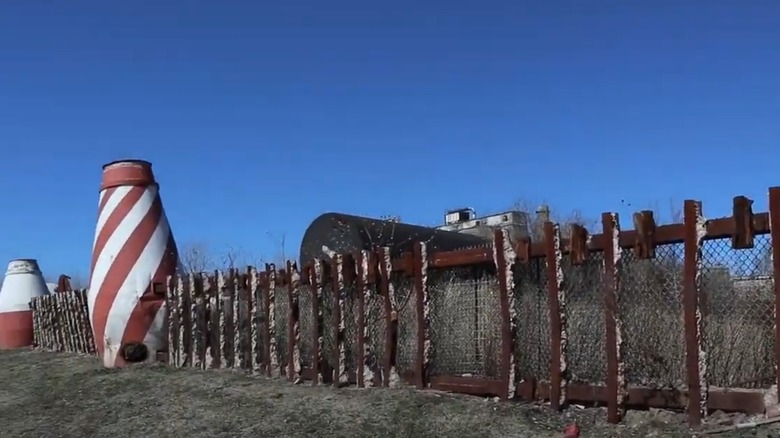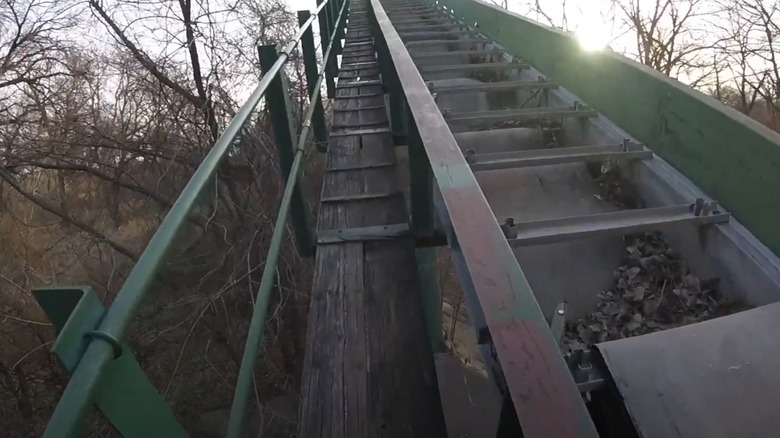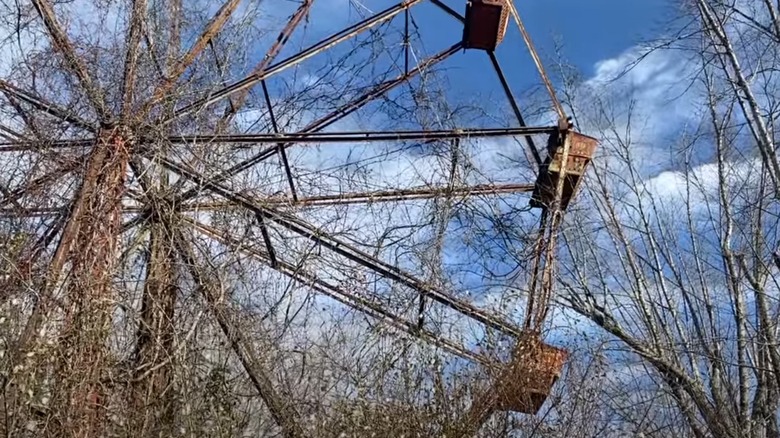The Creepiest Abandoned Amusement Parks You Can Visit Across America
There's something fascinating, nostalgic, eerie, and sometimes even just a little macabre about the often dangerous world of urbex (short for "urban exploration"), the hobby where explorers, usually armed with cameras or phones, explore long-forgotten, abandoned spaces in various stages of decay. And some of the most compelling spaces urban explorers like to explore are those that once served as a destination for fun and merriment — long-abandoned amusement parks that look like they belong in "The Walking Dead."
As leaves, algae, and rust gradually take over places where children once squealed in delight, there's a poetic mingling of nostalgia and the macabre that reminds us of our own mortality. Factor in the broken dreams and dark lore that led to many of these amusement parks' downfalls, and a pilgrimage to these sites is the stuff of deliciously frightening analog horror nightmares — a perfect addition to horror lovers' fall bucket lists.
While most of these parks are closed to the public and trespassing would be both foolhardy and dangerous — not to mention potentially lead to an exorcism — we've been careful to include locations that at press time could be viewed from nearby. And if you read through all the way to the end, there's even a reputedly cursed amusement park you can stay at with the owner's blessing.
FastTrax in Fort Myers, Florida
Drone explorer Ben Stevens has a knack for finding surreal spaces that feel pulled from a fever dream for publication on What's the Jam? In his various wanderings, Stevens has caught images of eerie abandoned hospitals and even a strange house filled with floor-to-ceiling plushies that looks like something Ryan Murphy would dream up for "American Horror Stories." But by far, one of the most surreal spaces he has captured is the inside of a seemingly forgotten Florida theme park that was abandoned when it was barely reopened.
Published in summer 2024, Stevens' drone photos are unsettlingly dissonant as cheery, brand-new rides silently stew in algae. According to What's the Jam?, the park is called Test Track and closed in 2019 due to financial issues. A little research revealed the park's real name is FastTrax, and it was not financial issues but a streak of bad luck that led to the park's current state of decline. Formerly called Zoomers, the go-kart and mini golf-centered amusement park was temporarily shuttered during the pandemic and taken over by new owners, who reopened the park as FastTrax. But after Hurricane Ian came along to put a major damper on their plans in 2022, the owners have struggled to get on the same page with insurance companies and vendors to reopen. They ultimately decided to rebuild in a new location due to open in December 2024 while leaving the old place, at least for now, frozen in time.
Lake Dolores Waterpark in Newberry Springs, Connecticut
Quietly riding out the decades in the Mojave Desert about halfway between Las Vegas and Los Angeles and just off of I-15 is the remains of the water park known during its heyday as Lake Dolores Waterpark. When the park first opened in 1962, it was intended to serve as a much-needed respite for travelers between the two major tourist destinations.
The entire thing would be a health inspector's nightmare by today's standards: One park employee was even left paraplegic after a 1998 incident. The park's water system consisted of 273 acres of channels connecting shallow manmade ponds drawing water from an underground spring. A hill made with the ground dug out to create the system was covered in high-speed slides tourists would fly face-first down. High dives, stand-up slides, a trapeze, a zip line, and various other potential widowmakers thrilled tourists for decades before waning popularity led to the park's closure in the late 1980s. Although investors tried to bring it back in 1998 and again in 2002, they never managed to recapture the old magic, and the desert oasis closed permanently in 2004. Today, all that remains of the park is either burned out or covered in vibrant graffiti.
What remains of the water park's slides have made it a favorite spot for skateboarders to evade security and sneak into. But it can be appreciated from the side of the road without breaking the law — or any bones — in the process.
Eagle Park Amusement Park in Cache, Oklahoma
Built in 1957 near the Fort Sill military base, Eagle Park was the vision of local farmer Herbert W. Woesner Jr. He'd been inspired by Craterville, a local amusement park that opened in 1923 but shut down in 1957 to make room for the military base's expansion. Woesner, who grew up in the area, got started by purchasing Craterville's bumper cars, a Ferris wheel, and dark ride from the owner. Originally calling his park "Frontier Park," he soon changed the name to pay tribute to Comanche warrior Quanah Parker, who wore an eagle feather headdress.
Woesner began purchasing historic buildings to preserve on the amusement park grounds. He would ultimately collect a historic village of 31 of them, including Elk Mountain Ranger Station, Quanah Parker's "Star House," Picket House, Orient Drug Store, Sunnyside School, and Lawton Frisco Railroad Depot, and a log cabin, among others. During its heyday, the park also featured a roller skating rink, a merry-go-round, multiple Ferris wheels, mini golf, several carnival rides, and an education animal handling center that housed lizards, alligators, and even venomous snakes.
Sadly, the park was forced to close in 1986 when insurance rates finally got too steep. Even after a fire caused by a 1998 lightning strike took out several buildings, though, Woesner continued to give tours of the grounds. Although what's left is crumbling, the current owner sometimes gives Star House tours for donations. Just call or stop by the Quanah Trading Post first.
Pirates Cove Water Park near Iowa, Louisiana
A shaky YouTube upload from LONELYSTARURBEX exploring the ground of Pirate's Cove feels like the beginning of an indie analog horror. "We're on the way back from New Orleans and we ran into something crazy," a pierced young woman with fading blue hair triumphantly declares, motioning to the waterpark across the overgrown field behind her. "We looked it up and all that came up on Google Maps was 'abandoned theme park.' "
The pair passes what they jokingly call a "crop circle" before coming across two rows of small cabins that look like something out of "Fallout." Inside the first hangs a monstrously large spider. An atmosphere of foreboding hangs in the air as the pair cheerily explores once colorful but now long-faded slides, testing them out with a skateboard. Another YouTube video with drone footage posted to Beyond Civilization shows detached slides leading to grass and a conspicuous shortage of pools, adding to the air of uncanniness lingering over this strange place.
The Pirates Cove Water Park Facebook page only seems to amplify the analog horror vibes. The park's profile pic is an eerily retro 3D rendering of the main slide area. A series of grammatically sketchy posts repeatedly complain about local red tape and permitting costs. In 2018, the profile's posts abruptly end with the proclamation, "Thank you all, still waiting on heath dept. to do paperwork, should be today or tomorrow then." Tomorrow, huh?
Ghost Town Village in Asheville, North Carolina
Ghost Town Village, formerly Ghost Town in the Sky, somehow manages to merge spooky and enchanting into a strange, liminal space that feels like something from a fairy tale. The fact that it's in the middle of nowhere at an elevation of 4600 feet makes it even more mysterious and dreamlike. Located atop Buck Mountain in dreamy Maggie Valley about an hour from Appalachian hidden gem the Pisgah National Forest, this remote theme park is extremely difficult to access, a problem that would ultimately contribute to its demise. But even the story of how Ghost Town Village came to be is pretty strange.
To raise the funds needed to build it, the owners issued minimum-$10,000 debenture bonds to anyone and everyone who wanted to participate. By 1961, the 260-acre property, an old west town with an oddly midcentury aesthetic, was shipping droves of eager tourists to its peak via chairlift to enjoy can-can dancers, stagecoaches, a shootout at high noon in the street, and even a large roller coaster. After the chairlift failed in the 2000s, the property changed hands a couple of times. Despite consideration from various investors through the years, serious issues have always stood in the way.
Even if some folks have taken to calling the once prosperous amusement park "cursed," the park still has plenty of fans who remember it fondly. It's also a favorite destination of explorers like YouTuber Luke Explores, who spent hours exploring the fog-covered grounds.
Dinosaur World in Beaver, Arkansas
Hidden somewhere in fall-favorite Midwestern vacation spot the Ozark Mountains near the artsy town of Eureka Springs is a world of slowly decaying dinosaurs. This graveyard of concrete dinos known as Dinosaur World was started with a handful of dinos made by Emmet Sullivan, a sculptor famous for creating quite a few well-known roadside attractions including the giant Christ of the Ozarks statue with his arms outstretched atop Magnetic Mountain. Originally called Farwell's Dinosaur Park when it started in 1967, the dino park would expand its collection of prehistoric residents from around 10 to 100 or so large sculptures of dinosaurs, mammoths, cavemen, and even a 40-foot-tall King Kong statue.
At its peak, the park was a 65-acre tourist draw that didn't feature any rides, but did give guests a chance to drive through the park safari-style and feel like they were lost in their very own Jurassic Park. It was the kind of quirky place that felt retro moments after it opened, and people loved it for that.
Today, the once-colorful dinosaurs still inhabit the gorgeous countryside as fading ghosts representing not one but two long-gone eras, as seen in photographer Dax Ward's haunting images. The current owners are serious about enforcing their no-trespassing signs, so it's not even worth trying to gain access to the grounds. But it possible to see part of the park from the nearby roadside without breaking any laws, especially during the winter months when the trees are sparse.
Dogpatch USA in northwest Arkansas
Opened in 1968, Dogpatch, U.S.A. was a smallish theme park based on Al Capp's "Li'l Abner" comic strip. For unfamiliar younger generations, "Li'l Abner" appeared in the Sunday comics section of the newspaper from 1943 through 1977. The comic, which would most certainly not pass the vibe check by today's standards, revolved around the residents of an impoverished Appalachian community called Dogpatch and was replete with pejorative "hillbilly" stereotypes.
The family theme park was open from 1968 through the early 1990s, which means for much of the park's run, most of the kids who visited were likely unfamiliar with its characters. Under pressure from nearby attractions and theme parks with more to offer, like Disney alternative Silver Dollar City, the park closed its doors never to reopen in 1993.
Today, the rundown buildings, which were already built to look impoverished and broken down as part of the Dogpatch community, along with its gaping mine, look like "Silent Hill" B-roll. Talk from various investors interested in reopening the park included potential plans for its reincarnation as a Christian theme park. It was eventually picked up by the Bass Pro Shops Owner and in 2023, his development team was awarded more than $2 million to redevelop the site as a nature preserve. But the Marble Falls project's completion seems a long way off, and much of the park is still there and can be seen from Highway 7 — along with the ghosts that allegedly haunt the grounds.
Cementland in St. Louis, Missouri
Told in broad strokes, the wasted concrete paradise of Cementland seems like a sad, dark tale of a strange man killed by his obsession. Superficially, it's a story about a man who poured his heart, like so much cement, into a bonkers pipe dream of a bizarre amusement park only to be killed at the site he'd put years into, apparently crushed by a bulldozer he'd been driving when it flipped while going downhill.
But if the man behind Cementland was a kook, he was a gifted one whose artistic vision transformed St. Louis. A sculptor whose brain worked entirely outside of the box, Bob Cassilly was the genius curator behind City Museum, a quirky, hands-on museum that repurposes industrial refuse into a massive, IRL game of Chutes & Ladders. It's the kind of idea that sounds daft on paper but is nothing short of magical in its execution. With that same level of vision and creativity, Cassilly hoped to create a similar playground using the concrete structures of an old abandoned cement factory. Cassilly had been out there doing the thing for about four years when he met his tragic end, which his widow Giovanni claims was murder — a claim that would be supported by a medical examiner's conclusion that he was beaten to death. Although the property was sold at auction in 2022, the remains of Concreteland, at least for now, can still be viewed from Scranton Avenue, particularly during the winter months.
Joyland in Wichita, Kansas
Once the largest theme park in central Kansas, not to mention one of the largest theme parks in the Midwest, Wichita's Joyland was beloved for quirky, iconic rides like the psychedelic Wacky Shack dark ride, a classic wooden roller coaster, and a miniature steam locomotive. Like most amusement parks that remain open long enough, Joyland would experience its share of tragedies through the years. In 1977, a seven-year-old died when he fell from a roller coaster while standing up in the rear car. Two out-of-control young men killed a park employee in the parking lo in the early 1980s, and in 1998, a groundskeeper was killed by an overhead roller coaster while trimming weeds.
By 2004, the park had a new owner who was already missing payments to the insurance company. When a 13-year-old tumbled thirty feet from a Ferris wheel, the owner's inability to work things out with the park's insurance company would set Joyland on its path to becoming a future abandoned theme park, with the park closing for good in 2007. Serious acts of vandalism and looting followed by an opera house fire over the next few years would ultimately seal the park's fate.
Nearly two decades of decay have left the park in an apocalyptic state of ruin, one that explorers have noted bears the stench of sulfur. In between the remains of a rusted-out roller coaster here or a vandalized waterslide there lie copious piles of rubble and burnt-out structures.
Lake Shawnee Amusement Park in Rock, West Virginia
For fans of places with dark histories and spooky ghost tours, what remains of Lake Shawnee Amusement Park is a dream — albeit the eerie kind that haunts you long after you wake. Located in West Virginia, a state home to some of America's best fall destinations, the abandoned amusement park is brimming with dark lore. The land, which many consider cursed, has been featured in numerous TV shows including ABC Family's "Scariest Places on Earth" and History Channel's "The UnXplained." But you don't have to settle for streaming it since Lake Shawnee Amusement Park actually encourages people to stop by and commune with the dead.
The dark history of Lake Shawnee dates back to 1783 when several Shawnee men killed and scalped the children of the first white settlers, burning one of them at the stake. Centuries later, artifacts would later uncover a mass grave site there that Marshall University experts say points to an epidemic wiping out a large swath of the Shawnee community years prior to the settlers' arrival.
Long before this information came to light, the grounds were developed into an amusement park in 1926, and the area was wildly popular until sometime around the midcentury when a couple of deaths allegedly began to impact the park's business. Shortly after an 11-year-old boy drowned in July 1966, the park closed. Aspiring ghost hunters can now experience the allegedly haunted grounds by booking a daytime tour or overnight experience.
